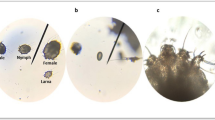Abstract
Echinostoma trivolvis adults are rejected from ICR mice within 3 weeks postinfection (p.i.) but are retained in golden hamsters for >15 weeks. The present study used scanning electron microscopy (SEM) to examine worm topography in ICR mice, particularly that of the collar spines, and to correlate worm loss with tegumentary changes. The topography of the worm in ICR mice was similar to that observed in previous studies on this echinostome in domestic chick embryos, chickens, and golden hamsters. Observations were made on the pattern of collar spines in 115 worms from ICR mice at 3–14 days p.i. All worms examined at 3 days exhibited extended spines, whereas about 70% of the worms examined at 14 days displayed retracted or missing spines. Eight worms from golden hamsters examined at 14 days p.i. showed extended collar spines. The retraction or loss of collar spines may play a role in the expulsion ofE. trivolvis from ICR mice.
Similar content being viewed by others
References
Anderson JW, Fried B (1987) Experimental infection ofPhysa heterostropha, Helisoma trivolvis andBiomphalaria glabrata (Gastropoda) withEchinostoma revolutum (Trematoda) cercariae. J Parasitol 73:49–54
Beaver PC (1937) Experimental studies onEchinostoma revolutum (Froelich) a fluke from birds and mammals. Ill Biol Monogr 15:1–96
Donovick RA, Fried B (1988) Scanning electron microscopy ofEchinostoma revolutum andE. liei from domestic chicks. J Penn Acad Sci 62:78–82
Franco J, Huffman JE, Fried B (1986) Infectivity, growth, and development ofEchinostoma revolutum (Digenea: Echinostomatidae) in the golden hamster,Mesocricetus auratus. J Parasitol 72:142–147
Fried B, Fujino T (1984) Scanning electron microscopy ofEchinostoma revolutum (Trematoda) during development in the chick embryo and the domestic chick. Int J Parasitol 14:74–81
Fried B, Vates TS (1984) In vitro maintenance and tracking ofEchinostoma revolutum (Trematoda) adults. Proc Helminthol Soc Wash 51:351–353
Fried B, Irwin SWB, Lowry SF (1990) Scanning electron microscopy ofEchinostoma trivolvis andE. caproni (Trematoda) adults from experimental infections in the golden hamster. J Nat Hist 24:433–440
Hosier DW, Fried B (1986) Infectivity, growth and distribution ofEchinostoma revolutum andE. liei in ICR mice. Proc Helminthol Soc Wash 53:173–176
Huffman JE, Fried B (1990)Echinostoma and echinostomiasis. Adv Parasitol 29:215–269
Kanev I (1985) On the morphology, biology, ecology and taxonomy of theE. revolutum group (Trematoda: Echinostomatidae:Echinostoma). PhD Dissertation, University of Sofia, Bulgaria
Smales LR, Blankespoor HD (1984)Echinostoma revolutum (Froelich, 1802) Looss, 1899 andIsthmiophora melis (Schrank, 1988) Luhe, 1909 (Echinostomatidae, Digenea): scanning electron microscopy of the tegumental surfaces. J Helminthol 58:187–195
Weinstein MS, Fried B (1991) The expulsion ofEchinostoma trivolvis and the retention ofEchinostoma caproni in the ICR mouse: pathological effects. Int J Parasitol 21:255–257
Author information
Authors and Affiliations
Rights and permissions
About this article
Cite this article
Kruse, D.M., Hosier, D.W. & Fried, B. The expulsion ofEchinostoma trivolvis (Trematoda) from ICR mice: scanning electron microscopy of the worms. Parasitol Res 78, 74–77 (1992). https://doi.org/10.1007/BF00936185
Accepted:
Issue Date:
DOI: https://doi.org/10.1007/BF00936185




